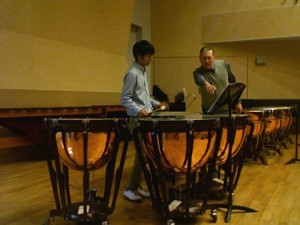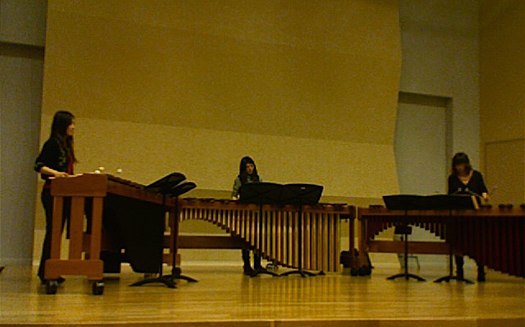It’s January 15, 2010 (Japan time) – the last day of my 2-week residency at the Showa Academy of Music. This has been my seventh such residency since 1998 – the third time at the school’s new campus facility in Kawasaki. The old campus was in Atsugi, about another 40 minutes southwest away from Tokyo and difficult to reach by bus.
The new campus is located a short walk from the Shin-Yurigaoka train station on the Odakyu Line. It’s very conveniently located for access, not only by the students and faculty, but also by audiences wanting to attend the opera, ensemble, and solo concerts and recitals. The school, because of the new facility and its location in a somewhat isolated residential area favored by retirees, is increasingly a desirable choice for music students as the prestige of its graduates and faculty is also on the rise in Japan.
My accommodations are at the Hotel Molina Shin-Yuri, a very nice new building located next to the train station. It’s quiet, relatively roomy (for Japan) and comfortable. There are also three department stores and a number of restaurants and small shops in the central square adjacent to the train station.
My work has been primarily associated with the school’s percussion department, which consists of about 30 college students and 5 faculty, chaired by Kazunori Meguro, who is also the new President of the Japan Percussive Arts Society. Every time I have returned to Showa, the general level of performance has increased.
My daily schedule during this visit has mostly consisted of five private 1-hour lessons plus a 1-hour workshop or masterclass per day. For the first time, this residency is two days shorter than in the past with no free days, but I enjoy working with the Showa students very much.

In their private lessons the students are mostly working on solo pieces in preparation for the approaching February exams, rather than on method books or etudes. Many of the solo pieces are with piano accompaniment. Here is a listing of all of the repertoire I have heard in lessons and workshops:
ADVENTURES FOR ONE by Robert Stern (Multi-percussion, unaccompanied)
CINQ PIECES BREVES by J. Delecleuse (Multi-percussion, piano accomp.)
CONCERT FOR MARIMBA AND STRINGS by E. Sejourné; (Marimba solo, piano accomp.)
CONCERTINO FOR MARIMBA by Paul Creston (Marimba solo, piano accomp.)
CONCERTINO POUR PERCUSSION et ORCHESTRE by J. Balissat (Multi-perc., pno. accomp.)
CONCERTINO FOR XYLOPHONE by Toshiro Mayazumi (Xylophone solo, piano accomp.)
CONCERTO FOR MARIMBA AND ORCHESTRA by N. Rosauro (Marimba solo, piano accomp.)
CONCERTO FOR PERCUSSION AND ORCHESTRA by E. Levitas (Multi-perc, pno. accomp.)
CONCERTO POUR BATTERIE et PETITE ORCHESTRE by D. Milhaud (Multi-perc., pno. accomp.)
CONCERTO FOR PERCUSSION by Andre Jolivet (Multi-perc, pno. accomp.)
CONCERTO FOR TIMPANI by Russell Peck (Timpani, piano accompaniment)
EIGHT PIECES FOR TIMPANI by Elliot Carter (Timpani, unaccompanied)
ELECTRIC GRASS by Claus-Dieter Zimmer (Marimba quartet)
GROUND FOR SOLO PERCUSSIONIST by N. Fukushi (Multi-percussion, unaccompanied)
IMPROVISATIONS (Masterclass/Workshop)
I-CHING by Per Norgaard (Multi-percussion, unaccompanied)
IONISATION by Edgard Varese (Percussion ensemble)
KYAKOU by E. Dupin (Multi-percussion, piano accomp.)
KHAN VARIATIONS by Alejandro Vinao (Multi-percussion, unaccompanied)
MATRE’S DANCE by John Psathas (Multi-percussion, piano accomp.)
MIRAGE FOR MARIMBA by Yasuo Sueyoshi (Marimba, unaccompanied)
MYRIADES by Francois Dupin (Multi-perc, piano accomp.)
PERCUSSION CONCERTO by R.R. Benett (Multi-percussion, piano accomp.)
PORTRAITS IN RHYTHM by A. Cirone (Snare Drum etudes, unaccompanied)
QUATRE INVENTIONS by Michel Cals (Multi-perc, piano accomp.)
REBONDS B by Iannis Xenakis (Multi-percussion, unaccompanied)
ROMAN CARNIVAL OVERTURE by H. Berlioz (Masterclass)
ROTATION 4 by Eric Sammut (Marimba, unaccompanied)
SCULPTURE IN WOOD by R. Pawassar (Marimba trio)
SIDE BY SIDE by Michio Kitazume (Multi-percussion, unaccompanied)
SIX SUITEN FUR VIOLONCELLO – No.6 Gavotte I and II – by J.S. Bach (Marimba, unaccompanied)
SUITE ANCIENNE by Maurice Jarre (Multi-perc, piano accomp.)
SUITE FOR PERCUSSION by Jean Albain (Multi-perc, piano accomp.)
SUITE IN Eb by G. Holst (Masterclass)
SYMPHONY No. 5 by L.v.Beethoven (Timpani with piano accomp.)
THIRTEEN DRUMS by Maki Ishii (Multi-percussion, unaccompanied)
TIMPANI ETUDES by John Beck (Timpani etudes, unaccompanied)
TROIS DANCES PAIENNES by Serge Baudo (Multi-perc., piano accomp.)

Among the observations that have stood out from this residency are:
1) The students have virtually eliminated the “gremlins” – the annoying unintended rattles and vibrations of cymbal stands, drum stands, stick trays and cradles, etc. The next step will be an improvement in using stick trays to park sticks and mallets, instead of on snare drums or overcrowded glockenspiels, xylophones and tambourine tables.
2) The students have really improved their organizing of multi-perc setups (instrument placement) in the interest of getting efficient hand/arm/body movements when playing.
3) Even though I have removed blankets from virtually every pedal bass drum used in the multi-perc pieces, the blankets have continually managed to find their way back inside. The one ray of hope for an open pedal bass drum sound (without my prodding) occurred in a lesson on the Mihaud CONCERTO FOR PERCUSSION, in which a decent sounding concert bass drum with a pedal was used. (This bass drum sound scenario is not limited to Showa or Japan; unfortunately, it’s now a ubiquitous paradigm.)
4) The students seemed to really enjoy the two masterclasses on playing in large ensembles – a subject that is often shorted in college study. One masterclass was on the SUITE IN Eb for wind ensemble by Gustav Holst. The other masterclass was on ROMAN CARNIVAL OVERTURE by Hector Berlioz. Every student had an opportunity to play as a section through passages of the pieces in rotation on the various percussion instruments in the parts. Technically, the percussion parts in both of these works are relatively simple, though there was discussion on technical concerns specific to the pieces, but the important issues are not technical; the important issues in orchestra/band performance are creating appropriate sounds, phrasing, duration of ring, dynamics, and ensemble (togetherness with other instruments – both within the percussion section and in the band/orchestra). Among the key points were some common sense
suggestions, as in always having a pencil (“your best friend”) nearby to mark cues and conductor’s instructions, and at the beginning of every multi-measure rest in the part, to write in the name of the band/orchestra instrument(s) you hear – for example, Fl., Vln. Ob. – as added cues.
5) On each successive visit to Showa, I have noticed that the students are more assertive in asking questions – good questions – and I find this to be a very positive development.
6) One observation that I found interesting to consider, though it’s an intuitive rather than a scientific observation, was that there seems to be a correlation between students who play mostly from memory and a self-centered mindset that makes it difficult for them to play easily with others in an ensemble. In contrast, the students who are readers seem to be able to play more easily with others in an ensemble. This speculative solo player vs. ensemble player personality contrast might be a good subject for an academic (psychological?) study.
7) Generally, I find it challenging to musically embrace much of the French multi-perc pieces composed from the 1950s through 1970s. However, that being said, I do value the learning that comes from performing with a piano accompaniment. It’s a distilled form of ensemble playing in contrast to solo unaccompanied pieces. The piano can exert a healthy sort of discipline in performance.
All in all, I hope that my brief visits – past and present – to Showa have been helpful to the students, most of whom, even with their very high performance skill levels, will likely go into other professions and participate in music for personal enrichment.
The flight home (via Chicago connection) will be a 12-hour plus 2-hour journey made more comfortable by a good book (currently, SALEM WITCH JUDGE, THE LIFE AND REPENTANCE OF SAMUEL SEWALL, a non-fiction biography of the only judge in the 1692 Salem witch trials to express remorse), a nice glass of wine and maybe a movie or two.
